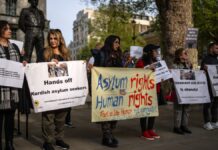 Infosys is one of India’s most storied IT companies with a roster of impressive clients in the US, including named Wall Street Banks, Silicon Valley companies, retail chains, insurance companies and manufacturers. With a footprint all over the world and known for its integrity and probity, it thus came as a surprise that the United States accused Infosys of malfeasance in procuring visas for its foreign national employees to come to the US.
Infosys is one of India’s most storied IT companies with a roster of impressive clients in the US, including named Wall Street Banks, Silicon Valley companies, retail chains, insurance companies and manufacturers. With a footprint all over the world and known for its integrity and probity, it thus came as a surprise that the United States accused Infosys of malfeasance in procuring visas for its foreign national employees to come to the US.
The US Attorney’s Office for the Eastern District of Texas, in conjunction with the Department of Homeland Security, launched an investigation in 2011 into Infosys’s alleged misuse of B-1 business visas. The investigation was spurred by a whistleblower’s law suit that made similar allegations, which got dismissed. On October 30, 2013, Infosys reached a settlement agreeing to pay a civil fine of $34 million to the US government, the biggest fine ever paid for an immigration case, but did not admit to the allegations of fraud and malfeasance.
There are plenty of lessons one can take away from the Settlement Agreement upon an objective review. Despite the seriousness of the allegations, Infosys did not incur any criminal liability. For instance, the government accused, among other things, the IT giant for bringing its employees on B-1 business visas to the United States to actually perform work.
The government further accused Infosys of generating invitation letters to US consular officials indicating that their purpose of travel was for “meetings” and “discussion” when the true purpose was to work in the US, which can only be performed under the more onerous H-1B visa, such as coding and programming. Infosys, on the other hand, countered that it has always used the B-1 visa for legitimate purposes and not to circumvent the H-1B visa.
Infosys also stated that the Department of State’s Foreign Affairs Manual permits other activities under the B-1 visa provided that they are incident to international trade or commerce, including those alleged by the US to be improper, such as coding and programming. The government also accused Infosys of directing its employees to misrepresent that they would be performing work at the location stated on the Labor Condition Application (LCA) underlying the H-1B visa petition, when they would actually be going to work at another location. Infosys also denied this accusation.
Infosys, however, admitted to violations concerning its obligations to verify employees on form I-9. Still, despite the denial of any fraud or malfeasance, Infosys paid a humongous fine of $34 million.
It was indeed the ambiguity in the B-1 rules that snared Infosys and it was the same ambiguity in the B-1, which ultimately saved it from criminal liability. This is evident in the statement of the lead prosecutor in the case, Shamoil Shipchandler, who is quoted in a Wall Street Journal article:
“It’s not 100% clear what someone who holds a B-1 visa can actually do,” he said.
For example, placing someone within a company for six months to do in-house tech support is an improper use of a B-1 visa. But if a consultant helps refine software during a meeting with a client, as part of a larger project, that could be seen as an appropriate use of a visitor visa, Mr. Shipchandler said. “It’s a murky area, but for our purposes they misled consular officials.”
The B-1 business visa remains one of the” most ill-defined” visas but plays a very important role in providing flexibility to business travelers. While the B-1 visa is associated with visiting the US to participate in meetings and negotiate contracts, it can have broader purposes.
For example, the “B-1 in lieu of H-1B” was created to facilitate travel to the US of individuals who would otherwise qualify for an H-1B visa, but only needed to come to the United States for a limited period of time.
In the current controversy over the B-1 visa, scant attention has been paid to the “B-1 in lieu of the H-1B,” which permits broader activities than the regular B-1 visa, albeit for a short period of time. Indeed, many of the activities that have been alleged to be outside the scope of the B-1 may be permissible under the “B-1 in lieu of the H-1B.” The case law with respect to business visitors only adds to the confusion over the definition of “business” in the US. In Matter of Hira, 11 I. & N. Dec. 824, the Board of Immigration Appeals (BIA) held that the term “business” does not include ordinary labor for hire, but is limited to intercourse of a commercial character.
The BIA concluded that an alien entering with a B-1 visa to “study the US business market”, who on behalf of his employer (a Hong Kong based manufacturer of custom made men’s clothing), took orders from, and the measurements of, prospective customers in the United States whom he did not solicit; and who then sent the orders, together with the purchase price, to his employer overseas, was engaged in “intercourse of a commercial character,” and was eligible for B-1 visitor for business classification.
The BIA specifically stated that Hira’s sojourn in the US was of a “temporary character” and he clearly intended to continue his foreign residence at the termination of his authorized stay.
The profits of Hira’s B-1 activities also accrued to the foreign entity. The BIA, however, also clarified that the nature of the business activity itself need not be temporary.
The BIA held that for B-1 purposes, the business relationship may be of a continuing or long standing nature. The only condition in this respect is that each visit be temporary in duration. While applicants can make their best case under the ambiguous standards of the B-1 visa in a forthright manner, deception and malfeasance can never be tolerated.
Even though Infosys is allowed to continue to access US visas in the future under the settlement, which also expressly ensures that past investigations or alleged wrongful conduct will not be used to prejudice future applications, this episode is a wakeup call for others to ensure that corporations exercise good governance with respect to immigration matters.
There is bound to be stricter scrutiny in the future of all applicants, and there is little doubt that Congress in future legislation may also use the Infosys example to tighten the ability for IT consulting firms to access business and work visas, as it has already accomplished in S. 744. Still, this episode can prove to be a valuable teaching moment for Infosys and other IT consulting firms.
One of the conditions under the settlement agreement is that Infosys will provide more detailed description of the activities that will be performed when an applicant applies for a B-1 visa. As the B-1 visa allows a wide range of permissible activities, a best industry practice can evolve to specify the proposed activities in some detail, and the legal basis for them, when applicants apply for a B-1 visa or at the time of seeking admission at a port of entry. As a quid pro quo, it is hoped that the government will also seriously adjudicate such applications on their merits.
Cyrus D. Mehta
To be continued






